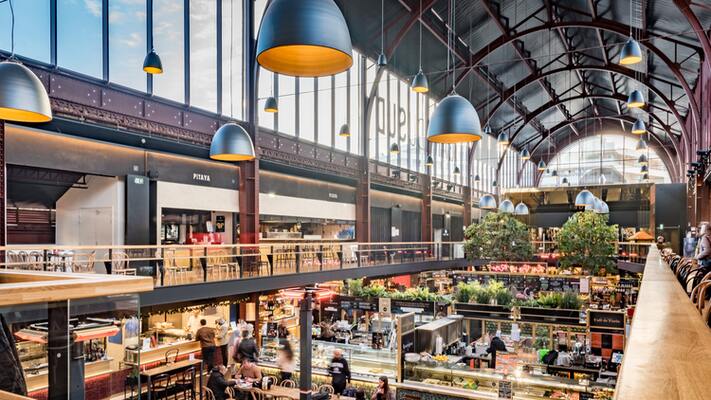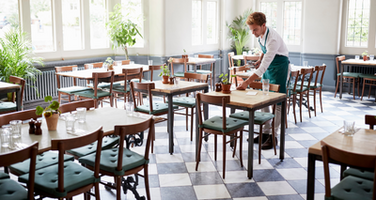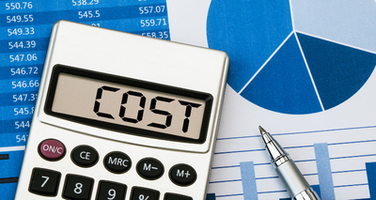
After two years of minimal to no dining in-person experiences, customers have finally begun to return to eating in restaurants. With this return, there are of course new dining trends and expectations. One of these emerging dining trends is the rise of food halls. These concepts are large buildings that are places to eat, shop, and gather. Humans are social creatures, and post-COVID, these are the perfect place for communities to share a meal from multiple food concepts.
This latest dining trend helps meet new customer expectations, such as the desire for a unique dining experience, an open space to gather, and the option to order from multiple food concepts. At the same time, this type of establishment simultaneously benefits food hall operators. A food hall set-up allows for lower staffing and rent costs, and therefore higher profit margins.
If you’re a vendor that sells to restaurants, now is the time to capitalize on the rise of food halls. Chances are the products you sell are greatly needed for these establishments to operate smoothly.
How food halls meet new customer expectations
After the pandemic, many customers prefer to have a more contact-free experience. Food halls can be set up in a way to accommodate this. For contact-free order and pay, customers can use QR codes or self-checkout kiosks. Food halls require less staff than a traditional restaurant, which allows for customers to naturally minimize their contact if this is preferred.
After staying home for two years, customers are looking to do more than just eat when they choose to eat out. They are looking for an experience, on top of excellent food. Food halls are spacious and have ample room to host special events or live music. Often, besides food concepts, there are small stores with clothing and handmade goods for shopping. All of these attractions serve to provide customers with the post-pandemic experience they are looking for.
Today, many customers have specific dietary preferences and restrictions. It can be difficult to choose a place to eat when one person is keto, the other is allergic to dairy, and another follows a gluten-free diet. The chances of one restaurant being able to accommodate these things is rather slim, but a food hall with 10-15 different food concepts can.
If two people are looking to dine out, one might want Indian food, while the other wants Italian. Instead of having to choose between restaurants, diners can have both when they dine in a food hall. We live in the age of personalization; customers seek restaurants and food concepts that accommodate their specific desires and custom orders, and food halls can do exactly that. When multiple customers can find exactly what they want in a food hall, this is what increases the success of this type of establishment.
Benefits of food halls for operators
Staffing is cited as one of the biggest challenges in the restaurant industry currently. On top of this, labor costs are one of the most expensive operational costs for a restaurant. Although food halls are typically large establishments, the normal amount of staff needed in a restaurant is not needed here. For example, most food halls do not require the standard amount of wait staff. Each food concept within the food hall can typically operate with one person manning the counter and one BOH (back-of-house) employee prepping the food. Or, if tech like a self-checkout kiosk is implemented, a FOH (front-of-house) employee is not needed.
Rent is cited as the other most expensive operating cost for restaurants. Food concepts located within food halls are operating out of spaces that are much smaller than normal restaurants, so, therefore, rent is much more affordable. Food concepts are not paying for the square footage of the dining area or bathrooms individually, so this helps rent costs low.
With less staff and lower rent costs, food concepts within food halls can reduce overall operational costs and therefore increase profits margins.
With lower operational costs and higher profit margins, foodservice operators can now more quickly expand their food concepts if desired. Opening multiple, standard-sized restaurants is costly. Small food concepts located in food halls can quickly bring attention and hype around the brand. Once the demand is established, operators can continue to expand the brand to other locations at a lower cost.
The foodservice industry is constantly changing, and it can be difficult for operators to stay on top of all emerging trends. Instead of completely changing a menu or doing a 180 flip when it comes to existing restaurant concepts to keep up with trends, food hall operators can simply add in a new food or beverage concept within the establishment.
Would your tech benefit a food hall establishment?
Take a moment to imagine everything that is needed to operate a food hall smoothly, post-COVID, and with new customer expectations. Modern POS systems and self-checkout kiosks are a definite yes. Scannable QR codes on tables and at the bar are also a logical choice in this setting. Does your food hall concept offer delivery and/or pick-up? If so, a delivery platform is necessary, while pick-up lockers would also make sense.
How to sell to food halls
If your technology or services would benefit a food hall operation, then consider using Brizo to find your ideal next customer. Brizo’s all-in-one data platform provides 500,000 data sources, delivering three unique scores for over 800,000 eating and drinking establishments. Food halls are not a trend that is expected to dissipate in the near future; this is the time to analyze what these establishments need to run smoothly. With Brizo, you can filter through and see what amenities establishments have and are lacking. Instead of cold emailing and calling, using Brizo will save time spent doing restaurant market research by 20-40 percent and boost sales conversion rate by up to 80 percent.







